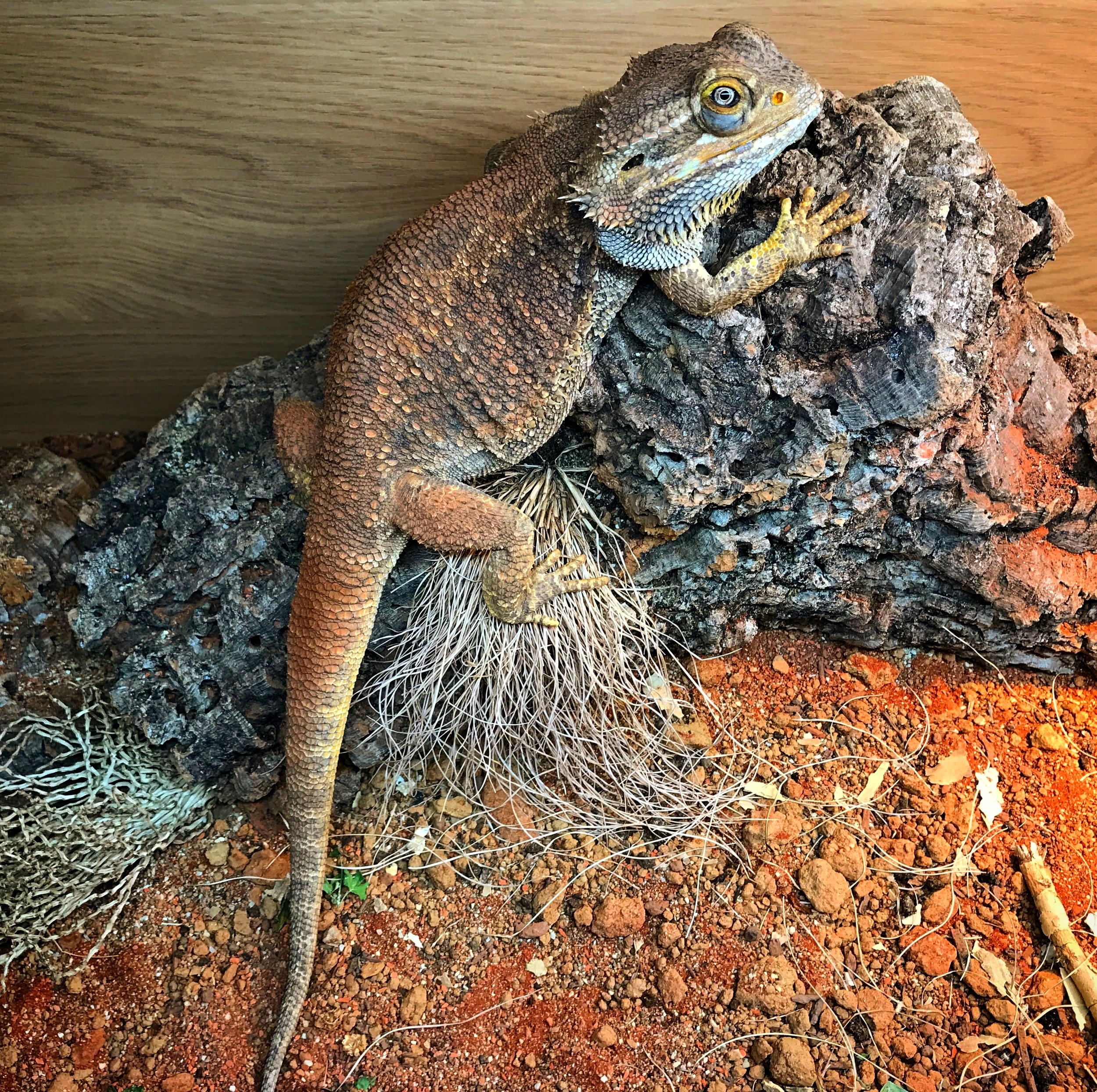BEarded Dragon
About Bearded Dragons
Area of origin: Australia
Adult size: 30-60cm
Captive lifespan: 10-15 years
If you’d like to see the setup for my Bearded Dragon, Yoshi, check out the video!
Housing, heating & lighting
Enclosure
Bearded Dragons are often quoted as requiring a 4x2x2ft enclosure. However, as reptile keeping progresses, and we learn more about their light and heat requirements, it is clear that the minimum sized enclosure for one adult Bearded Dragon is around 6x2x2ft, with 8x2x2ft being optimum. This not only gives your dragon a good floor space to exercise, it also provides them with some height to climb too- something which is very common in their wild counterparts.
As Beardies require such a vast heat gradient, a smaller enclosure often involves cutting corners, whereas a larger enclosure allows you to really have those hot basking spots and cooler burrows- we’ll talk more about heat in a moment!
Substrate wise, you’ll want to provide something that will retain heat well. I’m talking stones, sands, and clay. You can even mix in some soil if you’d like to. As you can see in the photo of Yoshi’s burrow, I’ve gone for a mix of each of those and replicated a small corner of the outback. For climbing, some slanted cork or acacia branches work brilliantly.
Heating
Bearded Dragons come from some of the hottest parts of the world, however they don’t often come out and bask in the heat of the day. So even though they can be found in regions of Australia that reach 50°C plus, it’s better to keep your captive Beardie a little more comfortable! I provide a basking temperature of 45°C and an ambient gradient of 40°C on the warm side, down to 24°C in the coolest end of the burrow. Night time temperatures don’t drop below 24°C in Yoshi’s enclosure. Again, not because they don’t drop further in the wild, but because that’s a comfortable temperature for him.
Yoshi’s heat is provided by 3 halogen bulbs of varying wattage- these are swapped and altered depending on the time of year.
Lighting
When it comes to lighting, we want to replicate wild light conditions as much as possible. Bearded Dragons need specific lighting to be healthy. You’ll need to provide a minimum of 12% UVB, with 14% UVB being preferred; this should cover three quarters of the enclosure, leaving one quarter without direct lighting- this is how we create a light gradient. I also like to use a natural 2% sunlight bulb to bring a warm glow to the enclosure. UVB should be provided for 10-12 hours per day.
Without high levels of UVB, Bearded Dragons cannot sythesise vitamin D3, and without D3, calcium isn’t absorbed in a high enough quantity for healthy bone growth and development. This can lead to Metabolic Bone Disease (MBD), and the dragon’s soft bones will develop crooked and malformed. It’s an incredibly painful condition that must be avoided at all costs. Luckily, with good husbandry, it’s easily avoidable!
Feeding & handling
Feeding
Bearded Dragons need a varied diet, including insects and plant matter. Young Beardies need 75% of their diet to be made up of insects, and can be fed daily. Juveniles and young adults need a 50/50 diet. They may need a little encouragement to eat their salad initially, but most come around! Try a few different foods until you find the one they’re fond of. Washed dandelion leaves often go down a treat! Adult and senior Beardies don’t need a high level of protein in their diet, and will often favour a higher level of plant matter, however they will still enjoy chasing down their bugs a few times each week!
When it comes to water, always provide a bowl of clean, fresh water when you get a new Beardie. Some will get all of their water from their food, but some will like to have a drink. Beardies favour moving water, so a fountain can also be used. Personally, we like to offer Yoshi a temperature controlled bath every other day. He will sometimes have a drink, but more than anything he likes to splash around. Get to know your dragon and see what they like best!
Handling
Bearded Dragons can become very tame if handled frequently and do seem to enjoy the regular contact. Whether they see us as giant walking heat sources, or as friends- who knows! Your Beardie will let you know if they’re not keen by displaying a big black beard and even puffing out to make themselves look bigger. It’s best not to grab your dragon if they do that, and instead, just leave your hand nearby, and perhaps offer some food until they calm down. Remember, they are prey animals, and being grabbed from above is similar to being picked up by a bird- so it’s kinder to scoop them up instead. Your dragon can hear you, so definitely talk to them, they’ll learn to recognise your voice.




